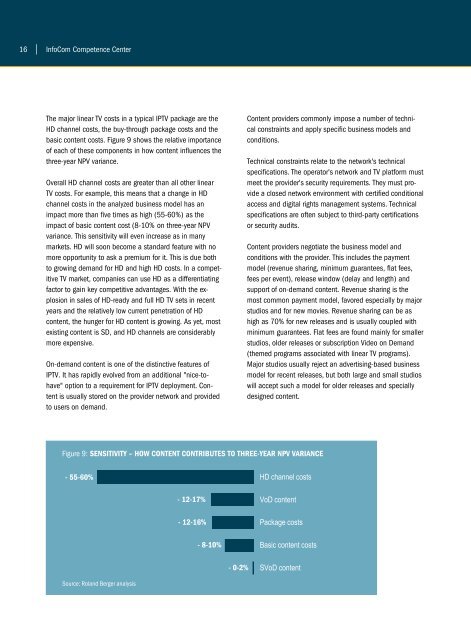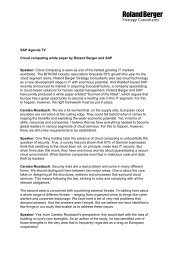The economics of IPTV - Roland Berger Strategy Consultants
The economics of IPTV - Roland Berger Strategy Consultants
The economics of IPTV - Roland Berger Strategy Consultants
- No tags were found...
You also want an ePaper? Increase the reach of your titles
YUMPU automatically turns print PDFs into web optimized ePapers that Google loves.
16InfoCom Competence Center<strong>The</strong> major linear TV costs in a typical <strong>IPTV</strong> package are theHD channel costs, the buy-through package costs and thebasic content costs. Figure 9 shows the relative importance<strong>of</strong> each <strong>of</strong> these components in how content influences thethree-year NPV variance.Overall HD channel costs are greater than all other linearTV costs. For example, this means that a change in HDchannel costs in the analyzed business model has animpact more than five times as high (55-60%) as theimpact <strong>of</strong> basic content cost (8-10% on three-year NPVvariance. This sensitivity will even increase as in manymarkets. HD will soon become a standard feature with nomore opportunity to ask a premium for it. This is due bothto growing demand for HD and high HD costs. In a competitiveTV market, companies can use HD as a differentiatingfactor to gain key competitive advantages. With the explosionin sales <strong>of</strong> HD-ready and full HD TV sets in recentyears and the relatively low current penetration <strong>of</strong> HDcontent, t the hunger for HD content t is growing. g As yet, mostexisting content is SD, and HD channels are considerablymore expensive.On-demand content is one <strong>of</strong> the distinctive features <strong>of</strong><strong>IPTV</strong>. It has rapidly evolved from an additional "nice-tohave"option to a requirement for <strong>IPTV</strong> deployment. Contentis usually stored on the provider network and providedto users on demand.Content providers commonly impose a number <strong>of</strong> technicalconstraints and apply specific business models andconditions.Technical constraints t relate to the network's technicalspecifications. <strong>The</strong> operator's network and TV platform mustmeet the provider's security requirements. <strong>The</strong>y must providea closed network environment with certified conditionalaccess and digital rights management systems. Technicalspecifications are <strong>of</strong>ten subject to third-party certificationsor security audits.Content providers negotiate the business model andconditions with the provider. This includes the paymentmodel (revenue sharing, minimum guarantees, flat fees,fees per event), release window (delay and length) andsupport <strong>of</strong> on-demand content. Revenue sharing is themost common payment model, favored especially by majorstudios and for new movies. Revenue sharing can be ashigh as 70% for new releases and is usually coupled withminimum guarantees. Flat fees are found mainly for smallerstudios, older releases or subscription Video on Demand(themed programs associated with linear TV programs).Major studios usually reject an advertising-based businessmodel for recent releases, but both large and small studioswill accept such a model for older releases and speciallydesigned content.Figure 9: SENSITIVITY – HOW CONTENT CONTRIBUTES TO THREE-YEAR NPV VARIANCE- 55-60% HD channel costs- 12-17%- 12-16%- 8-10%VoD contentPackage costsBasic content costs-0-2%SVoD contentSource: <strong>Roland</strong> <strong>Berger</strong> analysis

















